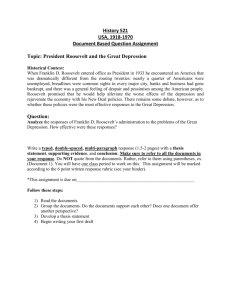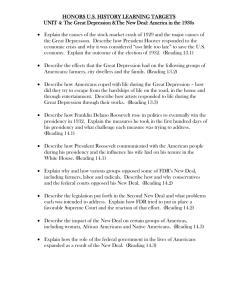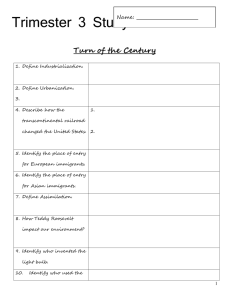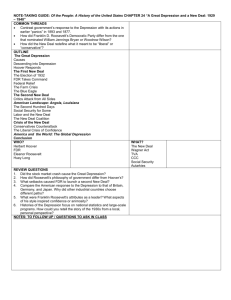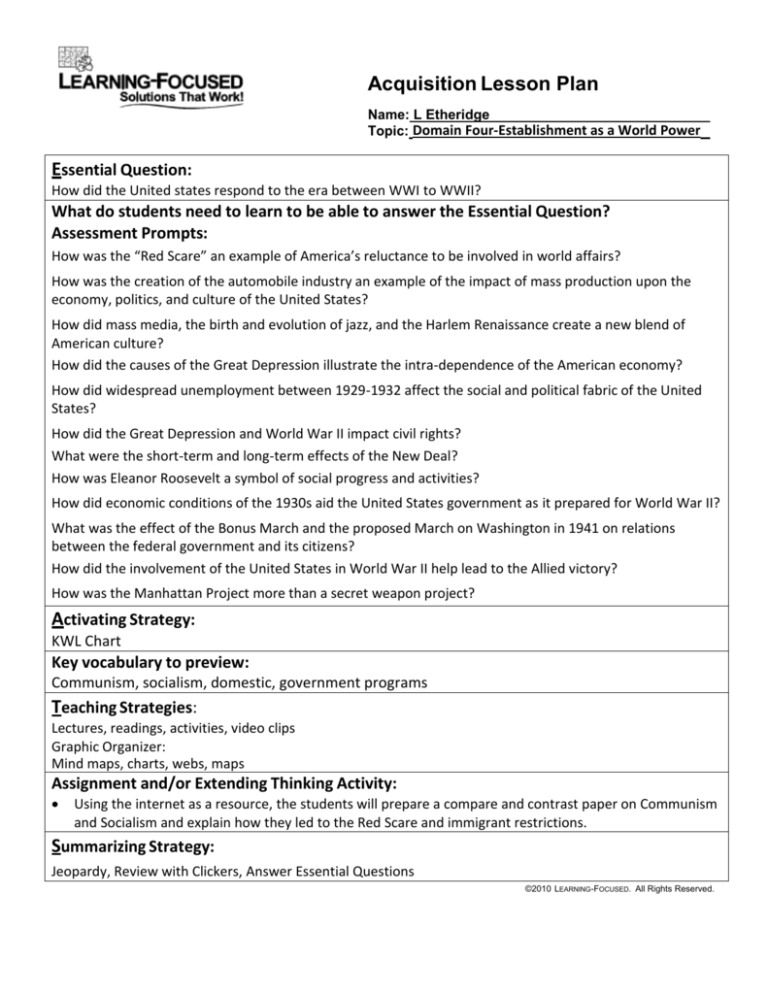
Acquisition Lesson Plan
Name: L Etheridge
Topic: Domain Four-Establishment as a World Power
Essential Question:
How did the United states respond to the era between WWI to WWII?
What do students need to learn to be able to answer the Essential Question?
Assessment Prompts:
How was the “Red Scare” an example of America’s reluctance to be involved in world affairs?
How was the creation of the automobile industry an example of the impact of mass production upon the
economy, politics, and culture of the United States?
How did mass media, the birth and evolution of jazz, and the Harlem Renaissance create a new blend of
American culture?
How did the causes of the Great Depression illustrate the intra-dependence of the American economy?
How did widespread unemployment between 1929-1932 affect the social and political fabric of the United
States?
How did the Great Depression and World War II impact civil rights?
What were the short-term and long-term effects of the New Deal?
How was Eleanor Roosevelt a symbol of social progress and activities?
How did economic conditions of the 1930s aid the United States government as it prepared for World War II?
What was the effect of the Bonus March and the proposed March on Washington in 1941 on relations
between the federal government and its citizens?
How did the involvement of the United States in World War II help lead to the Allied victory?
How was the Manhattan Project more than a secret weapon project?
Activating Strategy:
KWL Chart
Key vocabulary to preview:
Communism, socialism, domestic, government programs
Teaching Strategies:
Lectures, readings, activities, video clips
Graphic Organizer:
Mind maps, charts, webs, maps
Assignment and/or Extending Thinking Activity:
Using the internet as a resource, the students will prepare a compare and contrast paper on Communism
and Socialism and explain how they led to the Red Scare and immigrant restrictions.
Summarizing Strategy:
Jeopardy, Review with Clickers, Answer Essential Questions
©2010 LEARNING-FOCUSED. All Rights Reserved.
Acquisition Lesson Pacing Guide
Name: L Etheridge
Topic: Domain Four-Establishment as a World Power
Day 46 /Session 1
Day 47 /Session 2
Day 48 /Session 3
Essential Question:
Essential Question:
Essential Question:
What were the key
developments in the aftermath
of WWI?
What were the key
developments in the aftermath
of WWI?
What were the causes and
consequences of the Great
Depression?
Activating Strategy:
Daily 10
Activating Strategy:
Daily 10
Activating Strategy:
Daily 10
Key Vocabulary and Strategy
Communism
Mass Production
Red Scare
Socialism
Students copy and define in the
vocabulary section of their
notebook by folding paper in half
with one side having definition and
other the term/phrase
Henry Ford
Students describe the
accomplishments of the persons of
interest.
Key Vocabulary and Strategy:
Harlem Renaissance
Tin Pan Alley
Students copy and define in the
vocabulary section of their
notebook by folding paper in half
with one side having definition and
other the term/phrase
Louis Armstrong
Langston Hughes
Irving Berlin
Students describe the
accomplishments of the persons of
interest.
Key Vocabulary and Strategy:
Bull Market
Dust Bowl
Overproduction
Speculation
Stock Market
Underconsumption
Students copy and define in the
vocabulary section of their
notebook by folding paper in half
with one side having definition and
other the term/phrase
Teaching Strategies:
Teaching Strategies:
Teaching Strategies:
Students take turns reading
pages 163-165 in workbook
Students take turns reading
pages 165-167 in workbook
Students take turns reading
pages 167-169 in workbook
Complete cloze notes over
reading
Complete cloze notes over
reading
Complete Cloze notes while
reading.
Henry Ford Video clip
Discussion of innovations of the
1920s
Video clip from Discovery on
Technology and inventions of
the 1020s
Students will create an
information ad on chart paper
identifying a key development
in the aftermath of WWI. The
ads may include Henry Ford and
the auto industry, radio,
movies, origins of jazz, Harlem
Renaissance, Langston Hughes,
Irving Berlin, Tin Pan Alley, etc.
Read autobiographies of
Langston Hughes and Ernest
Hemingway
Complete graphic organizer
after each section of the
reading
Read selected poems of
Langston Hughes aloud
Complete Timeline Activity 22
Early Days of the Great
Depression
Create facebook page on one of
the notable people
View the United Streaming
video “American History From
the Great War to the Great
Depression” with accompanying
questions.
Students will then participate in
a gallery walk and create a list
of which they think is the most
important to the least
important development of
American society during the
post war era. Each student will
write a one page paper
supporting his or her choices.
Assessment Prompt
How was the “Red Scare” an
example of America’s reluctance to
be involved in world affairs?
How was the creation of the
automobile industry an example of
the impact of mass production
upon the economy, politics, and
culture of the United States?
Assessment Prompt
How did mass media, the birth and
evolution of jazz, and the Harlem
Renaissance create a new blend of
American culture?
Assessment Prompt
Summarizing Strategy:
Study Questions
Summarizing Strategy:
Study Questions
Summarizing Strategy:
Study Questions
How did the causes of the Great
Depression illustrate the intradependence of the American
economy?
©2010 LEARNING-FOCUSED. All Rights Reserved.
Day 49/Session 4
Day 50/Session 5
Day 51 /Session 6
Essential Question:
What were the causes and
consequences of the Great
Depression?
Essential Question:
How did Roosevelt’s New Deal
attempt to respond to the Great
Depression and what government
programs aided those in need?
Essential Question:
How did Roosevelt’s New Deal
attempt to respond to the Great
Depression and what government
programs aided those in need?
Activating Strategy:
Daily 10
Activating Strategy:
Daily 10
Activating Strategy:
Daily 10
Key Vocabulary and Strategy
Great Depression
Hobo
Hoovervilles
Stock Market Crash
Students copy and define in the
vocabulary section of their
notebook by folding paper in half
with one side having definition and
other the term/phrase
Key Vocabulary and Strategy:
Activism
New Deal
Relief
Second New Deal
Social Progress
Social Security Act
Tennessee Valley Ac t
Wagner Act
Students copy and define in the
vocabulary section of their
notebook by folding paper in half
with one side having definition and
other the term/phrase
FDR
Key Vocabulary and Strategy:
Activism
New Deal
Relief
Second New Deal
Social Progress
Social Security Act
Tennessee Valley Ac t
Wagner Act
FDR
Huey P. Long
Huey P. Long
Students describe the
accomplishments of the persons of
interest.
Teaching Strategies:
Teaching Strategies:
Students take turns reading
pages 169-170 in workbook
Complete cloze notes over
reading
Create second part of Great
Depression/New Deal mobile (Causes of the Great
Depression and Effects of the
Great Depression)Students will create a chart
divided into four sections
explaining the causes of the
Stock Market Crash 1929.
Those causes of the crash will
be presented with comments
for each reason given for the
crash. Justification for the
causes will be noted at the end
of the chart along with the
solution to the Stock Market
Crash of 1929 Crisis.
The Great Depression in 10
Minutes video clip by Hughes
DV
Students take turns reading
pages 170-173 in workbook
Complete cloze notes over
reading
Create second part of Great
Depression/New Deal mobile
(1st new deal and 2nd New Deal)
Time line for Agencies of the
New Deal (Page 71 in TAV
resources)
Graphic organizer of the
Causes and Effects of the Great
Depression
Complete the graph skills on
page 658 in textbook
View the United Streaming
video “American History-From
the Great War to the Great
Depression” with
accompanying questions.
Assessment Prompt
Assessment Prompt
How did widespread unemployment What were the short-term and
between 1929-1932 affect the social long-term effects of the New Deal?
and political fabric of the United
States?
Teaching Strategies:
Students use information
about the great depression,
causes, and New Deal
programs to create a mobile
describing each
Using internet sites to gather
research and photographs,
students will create a pictorial
graph of events leading to the
Great Depression. This graph
should include but not limited
to events surrounding the Dust
Bowl in the Midwest, as well as
the development of
Hoovervilles across the nation.
In class discussion, students
will explain the multiple
methods used by Franklin
Roosevelt’s New Deal to help
end the Great Depression.
Next, students will write a
report to explain how the
multiple methods used by
President Roosevelt impacted
the problems of the Great
Depression
Assessment Prompt
What were the short-term and
long-term effects of the New Deal?
Summarizing Strategy:
Study Questions
Summarizing Strategy:
Study Questions
Summarizing Strategy:
Study Questions
Day 52 /Session 7
Day 53 /Session 8
Day 54/Session 9
Essential Question:
How did Roosevelt’s New Deal
attempt to respond to the Great
Depression and what government
programs aided those in need?
Essential Question:
What led to the abandonment the
isolationist policy by the U.S. in our
decision to join Allied forces?
Activating Strategy:
Daily 10
Key Vocabulary and Strategy:
Bonus Army
Court Packing Bill
Neutrality Act
Students copy and define in the
vocabulary section of their
notebook by folding paper in half
with one side having definition and
other the term/phrase
Eleanor Roosevelt
Students describe the
accomplishments of the persons of
interest.
Essential Question:
How did the US contribute to the Allied
victory in the European and Pacific
Theaters?
Activating Strategy:
Daily 10
Activating Strategy:
Daily 10
Key Vocabulary and Strategy
Axis powers
Key Vocabulary and Strategy:
Allied Powers
European Theater
Battle of Midway
Battle of Berlin
D-Day invasion
Pacific Theater
Island hopping
Los Alamos
Neutrality Act
Fair Employment Act
Students copy and define in the
vocabulary section of their
notebook by folding paper in half
with one side having definition and
other the term/phrase
Adolf Hitler
Pearl Harbor
Benito Mussolini
Internment
A Philip Randolph
Lend-lease Act
Manhattan Project
Students describe the
accomplishments of the persons of Students copy and define in the
interest.
vocabulary section of their
notebook by folding paper in half
with one side having definition and
other the term/phrase
Dwight D. Eisenhower
Harry S. Truman
Students describe the
accomplishments of the persons of
interest.
Teaching Strategies:
Teaching Strategies:
Teaching Strategies:
Students take turns reading
pages 173-176 in workbook
Students take turns reading
pages 179-181 in workbook
Students take turns reading
pages 182-189 in workbook
Complete cloze notes over
reading
Students read about first ladies
then and now. (pg.72 in TAV
resources)
Complete cloze notes over
reading
Notes on events leading to
WWII
Cause and Event organizer for
WWII
After a discussion of
propaganda, in which the
teacher describes that
propaganda is a specific type of
message aimed at serving an
agenda, students will create a
World War II propaganda
Complete cloze notes over
reading
Students will create an
informative paper describing
the events of December 7,
1941. The program will also
suggest the need for
restrictions to be placed on
Americans of German, Italian,
and Japanese.
The students will create
presentations of the major
battles of World War II. Within
The New Deal in 10 Minutes video
clip by Hughes DV
Students will work as a whole
group study to analyze a
political cartoon concerning
the New Deal
Students will study a political
cartoon portfolio consisting of
samples revolving around
Franklin Roosevelt’s domestic
and international leadership.
The political cartoons are be
divided between domestic and
international leadership with
an explanation of each cartoon
and its impact on the American
public.
Students will analyze the cartoon
using the Cartoon Analysis form,
then share with class
Assessment Prompt
How was Eleanor Roosevelt a
symbol of social progress and
activities?
Summarizing Strategy:
Study Questions
Day 55/Session 10
Essential Question:
How did efforts on the home front
assist in an Allied victory?
poster. In their posters,
students are to describe the
war mobilization effort, as
indicated by war rationing,
war-time conversion, and the
role of women in war
industries. In their propaganda
posters, students must convey
patriotic goals and sacrifices
made during the war. Students
should be expected to present
their posters to the class and
explain how it relates to the
war mobilization effort.
Definition of Propaganda – a
specific type of message aimed
at serving an agenda. The
message may convey true
information, however usually it
fails to convey the entire
picture by portraying only one
side of an issue.
the presentations, students will
list where the event occurred,
what difficulties were faced by
the US in delivering supplies to
the troops involved, which
branches of the military were
included (Army, Navy, Air
Force), and the importance of
the event as it relates to
conflict and change.
World War II in Ten Minutes
with Hughes DV
Assessment Prompt
What was the effect of the Bonus
March and the proposed March on
Washington in 1941 on relations
between the federal government
and its citizens? How did economic
conditions of the 1930s aid the
United States government as it
prepared for World War II?
Assessment Prompt
How did the involvement of the
United States in World War II help
lead to the Allied victory?
Summarizing Strategy:
Study Questions
Summarizing Strategy:
Study Questions
Day 56 /Session 11
Essential Question:
How did the United states respond
to the era between WWI to WWII?
Day 57/Session 12
Essential Question:
How did the United states respond
to the era between WWI to WWII?
Activating Strategy:
Daily 10
Activating Strategy:
Daily 10
Activating Strategy:
Daily 10
Key Vocabulary and Strategy:
Key Vocabulary and Strategy:
2nd Great Migration, A Philip
Randolph, Activism, Adolf Hitler,
Allied Powers, Axis powers, Battle
of Berlin , Battle of Midway, Benito
Mussolini, Bonus Army , Bull
Market, Communism , Court
Key Vocabulary and Strategy:
2nd Great Migration, A Philip
Randolph, Activism, Adolf Hitler,
Allied Powers, Axis powers, Battle
of Berlin , Battle of Midway, Benito
Mussolini, Bonus Army , Bull
Market, Communism , Court
War-time Conversion
Rationing
War Production Board
Rosie the Riveter
2nd Great Migration
Mobilization
Packing Bill, D-Day invasion , Dust
Bowl, Dwight D. Eisenhower,
Eleanor Roosevelt, European
Theater , Fair Employment Act, FDR ,
Great Depression, Harlem
Renaissance, Harry S. Truman,
Henry Ford , Hobo, Hoovervilles,
Huey P. Long, Internment, Irving
Berlin, Island hopping , Langston
Hughes, Lend-lease Act, Los Alamos,
Louis Armstrong, Manhattan
Project , Mass Production,
Mobilization, Neutrality Act,
Neutrality Act , New Deal,
Overproduction, Pacific Theater ,
Pearl Harbor, Rationing, Red Scare ,
Relief, Rosie the Riveter, Second New
Deal, Social Progress, Social Security
Act , Socialism , Speculation, Stock
Market , Stock Market Crash ,
Tennessee Valley Ac t, Tin Pan
Alley, Underconsumption, Wagner
Act, War Production Board, War-time
Packing Bill, D-Day invasion , Dust
Bowl, Dwight D. Eisenhower,
Eleanor Roosevelt, European
Theater , Fair Employment Act, FDR ,
Great Depression, Harlem
Renaissance, Harry S. Truman,
Henry Ford , Hobo, Hoovervilles,
Huey P. Long, Internment, Irving
Berlin, Island hopping , Langston
Hughes, Lend-lease Act, Los Alamos,
Louis Armstrong, Manhattan
Project , Mass Production,
Mobilization, Neutrality Act,
Neutrality Act , New Deal,
Overproduction, Pacific Theater ,
Pearl Harbor, Rationing, Red Scare ,
Relief, Rosie the Riveter, Second New
Deal, Social Progress, Social Security
Act , Socialism , Speculation, Stock
Market , Stock Market Crash ,
Tennessee Valley Ac t, Tin Pan
Alley, Underconsumption, Wagner
Act, War Production Board, War-time
Conversion,
Conversion,
Teaching Strategies:
Teaching Strategies:
Teaching Strategies:
Students take turns reading
pages 190-192 in workbook
Students take turns reading
pages 206-213 in workbook
Complete cloze notes over
reading
Using History Frame organizer,
students will research World
War II
Students will research the
effects of the war on the home
front – rationing, conversion,
role of women, Japanese
American internment. They will
compose a 500 word minimum
paper summarizing the war
mobilization efforts
The students will write
newspaper editorial about the
changes that are occurring in
the United States due to the
war. Topics that must be
included are rationing, war time
conversion, and the role of
women.
Complete cloze notes over
reading
Analyze journals of Vietnam
soldiers
Take a stand poster activity
(either support the war (Korean
or Vietnam)or Anti war)
Students copy and define in the
vocabulary section of their
notebook by folding paper in half
with one side having definition and
other the term/phrase
Unit Test
Assessment Prompt
Assessment Prompt
How did WWII impact domestic life How was the Manhattan Project
in the United States?
more than a secret weapon
project?
How did the Great Depression and
World War II impact civil rights?
Assessment Prompt
Unit Test
Summarizing Strategy:
Study Questions
Summarizing Strategy:
Unit Test
Summarizing Strategy:
Study Questions
Know-Understand-Do Organizer
Name: Lorrie Etheridge
Course/Subject: US History
Topic: Domain Four-Establishment as a World Power
Which Standards are students learning in this unit?
SSUSH16 The student will identify key developments in the aftermath of WW I.
a. Explain how rising communism and socialism in the United States led to the Red Scare and immigrant restriction.
b. Identify Henry Ford, mass production, and the automobile.
c. Describe the impact of radio and the movies.
d. Describe modern forms of cultural expression; include Louis Armstrong and the origins of jazz, Langston Hughes and
the Harlem Renaissance, Irving Berlin, and Tin Pan Alley.
SSUSH17 The student will analyze the causes and consequences of the Great Depression.
a. Describe the causes, including overproduction, underconsumption, and stock market speculation that led to the stock
market crash of 1929 and the Great Depression.
b. Explain factors (include over-farming and climate) that led to the Dust Bowl and the resulting movement and
migration west.
c. Explain the social and political impact of widespread unemployment that resulted in developments such as
Hoovervilles.
SSUSH18 The student will describe Franklin Roosevelt’s New Deal as a response to the depression and compare the
ways governmental programs aided those in need.
a. Describe the creation of the Tennessee Valley Authority as a works program and as an effort to control the
environment.
b. Explain the Wagner Act and the rise of industrial unionism.
c. Explain the passage of the Social Security Act as a part of the second New Deal.
d. Identify Eleanor Roosevelt as a symbol of social progress and women’s activism.
e. Identify the political challenges to Roosevelt’s domestic and international leadership; include the role of Huey Long,
the “court packing bill,” and the Neutrality Act.
SSUSH19 The student will identify the origins, major developments, and the domestic impact of World War II,
especially the growth of the federal government.
a. Explain A. Philip Randolph’s proposed march on Washington, D.C., and President Franklin D. Roosevelt’s response.
b. Explain the Japanese attack on Pearl Harbor and the internment of Japanese- Americans, German-Americans, and
Italian-Americans.
c. Explain major events; include the lend-lease program, the Battle of Midway, D-Day, and the fall of Berlin.
d. Describe war mobilization, as indicated by rationing, war-time conversion, and the role of women in war industries.
e. Describe the Manhattan Project at Los Alamos and the scientific, economic, and military implications of developing
the atomic bomb.
f. Compare the geographic locations of the European Theater and the Pacific Theater and the difficulties the U.S. faced in
delivering weapons, food, and medical supplies to troops.
By the end of this unit, students will be able to…
KNOW:
Rising communism and socialism in
the United States
UNDERSTAND
Understand the challenges facing
the nation after WWI
Henry Ford as a mass producer of
the automobiles
Understand the causes and effects
of the Great Depression
Impact of radio and the movies
Understand how FDR responded to
DO:
Skills
How was the “Red Scare” an
example of America’s reluctance to
be involved in world affairs?
(USH16a)
How was the creation of the
Modern forms of cultural
expression
Causes & Effects of the Great
Depression
Social and political impact of
widespread unemployment
Creation of the Tennessee Valley
Authority
Rise of industrial unionism
(Wagner Act)
Passage of the Social Security Act
Eleanor Roosevelt as a symbol of
social progress
Roosevelt’s domestic and
international leadership
The vocabulary for Unit 6 (see
SLM)
the Great Depression
Understand FDR’s leadership at
home and impact abroad
automobile industry an example of
the impact of mass production
upon the economy, politics, and
culture of the United States?
(USH16b)
How did mass media, the birth and
evolution of jazz, and the Harlem
Renaissance create a new blend of
American culture? (USH16c, d)
How did the causes of the Great
Depression illustrate the intradependence of the American
economy? (USH17a)
How did widespread
unemployment between 19291932 affect the social and political
fabric of the United States?
(USH17b, c)
How did the Great Depression and
World War II impact civil rights?
(USH17c; USH19a, b)
What were the short-term and
long-term effects of the New Deal?
(USH18a, b, c, e; USH23c)
How was Eleanor Roosevelt a
symbol of social progress and
activities? (USH18d)
How did economic conditions of
the 1930s aid the United States
government as it prepared for
World War II? (USH18a: USH19d)
What was the effect of the Bonus
March and the proposed March on
Washington in 1941 on relations
between the federal government
and its citizens? (USH19a)
How did the involvement of the
United States in World War II help
lead to the Allied victory? (USH19c,
d, e)
How was the Manhattan Project
more than a secret weapon
project? (USH19e)
Launch Activities:
- Slideshow of Hoovervilles and pictures of Dust Bowl and discuss the progress of decline
- Out of the Dust, Karen Hesse
- Leah’s Pony Children’s book
- Listen to music from period
Formative Assessments:
- Student created presentation on assigned topic using technology
- Newspaper article responding to the Dust Bowl or unemployment rise (d,e)
- Advertisement of key people from the Harlem Renaissance (c)
- Cause and effect of Great Depression on the nation (d)
- Compare and contrast the New Deal and the Second New Deal (f, g)
- Pamphlet response to Eleanor Roosevelt’s social progress (h)
- Great Depression writing simulation (students are given different roles during the depression and Dust
Bowl, through the New Deal) (d, e)
- Journal – You are there diaries (a, b, c, d, e)
- Primary Source readings from Harlem Renaissance (c)
- Analyze primary sources
Summative Assessments:
- Appropriate Vocabulary, Map, or Review Quizzes
- Multiple Choice Exam (reflective of U.S. History EOCT) with short answer/essay options
Additional Resources:
- Leah’s Pony Children’s book
- Out of the Dust, Karen Hesse
- Harlem Renaissance music http://www.jcu.edu/harlem/Audio/Page_1.htm
- Soup kitchens and bread lines http://www.history.com/topics/hoovervilles/photos
- Images of Great Depression http://loc.gov/teachers/
- FDR Political cartoons - http://www.nisk.k12.ny.us/fdr/
Student Learning Map
Name: L Etheridge
Course/Subject: U.S. History
Topic: Domain Four-Establishment as a World Power
School: Glynn Academy
School District: Glynn County
Key Learning:
Key economic, political, and social developments in the United States between World War I and World II.
World War II changed the United States in terms of domestic relations and governmental influence.
Unit Essential Question: How did the U.S. government respond to key economic, political,
and social developments between World War I and World War II?
How did WWII impact United States?
Concept: Red Scare
Concept: 1920’s and the Harlem
Renaissance
Concept: The Great Depression
Lesson Essential Questions:
How did Americans respond to
the threat of communism and
socialism after WWI?
Lesson Essential Questions:
How did the popular culture of
the U.S. evolve during the
1920s?
Lesson Essential Questions:
How did the success of the
1920s lead to the Great
Depression?
How did the Stock Market
Crash effect the lives of U.S.
citizens
Vocabulary:
Red Scare
Communism
Socialism
Vocabulary:
Henry Ford
Mass Production
Louis Armstrong
Langston Hughes
Irving Berlin
Tin Pan Alley
Vocabulary:
Overproduction
Underconsumption
Stock Market
Bull Market
Speculation
Hoovervilles
Hobo
Great Depression
Stock Market Crash
Dust Bowl
Bonus Army
Concept: FDR’s Presidency
and the New Deal
Concept: Causes of
World War II
Concept: Major Events
and Battles of WWII
Concept: The War at
Home
Lesson Essential Questions:
How did FDR respond to
the challenges faced by
his administration?
How did the New Deal
differ from the Second
New Deal?
Lesson Essential
Questions:
What led to the
abandonment the
isolationist policy by
the U.S. in our
decision to join Allied
forces?
What was the
domestic impact of
the Japanese
bombing of Pearl
Harbor?
Lesson Essential
Questions:
How did the US
contribute to the
Allied victory in the
European Theater?
How did the Los
Alamos project
impact the end of
the war with Japan?
Lesson Essential
Questions:
How did efforts on
the home front assist
in an Allied victory?
Vocabulary:
FDR
Eleanor Roosevelt
Huey P. Long
Relief
New Deal
Social Security Act
Tennessee Valley Ac t
Wagner Act
Social Progress
Activism
Labor Union
Neutrality Act
Court Packing Bill
Vocabulary:
Pearl Harbor
Internment
Lend-lease program
Mobilization
FDR
Allied Forces
Axis Forces
Adolf Hitler
Benito Mussolini
Joseph Stalin
Winston Churchill
Vocabulary:
Allied Forces
Axis Forces
European Theater
Battle of Midway
Battle of Berlin
D-Day invasion
Dwight D.
Eisenhower
Harry S. Truman
Pacific Theater
Island hopping
Los Alamos
Manhattan Project
Vocabulary:
War-time Conversion
Rationing
War Production
Board
Fair Employment Act
Neutrality Act
Rosie the Riveter
Great Migration
Additional Information/Resources:
Henry Ford, http://www.hfmgv.org/exhibits/hf/
Great Depression, http://www.history.com/topics/great-depression
Great Depression Timeline, http://www.pbs.org/wgbh/americanexperience/features/timeline/rails-timeline/
New Deal, http://newdeal.feri.org/
The Dust Bowl, http://www.pbs.org/wgbh/americanexperience/features/general-article/dustbowl-new-deal/
http://www.militaryaviationmuseum.org/
http://www.brainpop.com/socialstudies/worldhistory/worldwariicauses/preview.weml
http://www.kidskonnect.com/subject-index/16-history/288-world-war-ii.html
http://www.socialstudiesforkids.com/subjects/worldwarii.htm
http://ehistory.osu.edu/world/TimeLineDisplay.cfm?Era_id=16
http://www.solpass.org/7ss/standards/MajorEvents.htm
http://www.historylearningsite.co.uk/WORLD%20WAR%20TWO.htm
http://www.history.com/topics/battle-of-midway
http://www.history.com/topics/d-day
http://www.history.com/topics/american-women-in-world-war-ii


